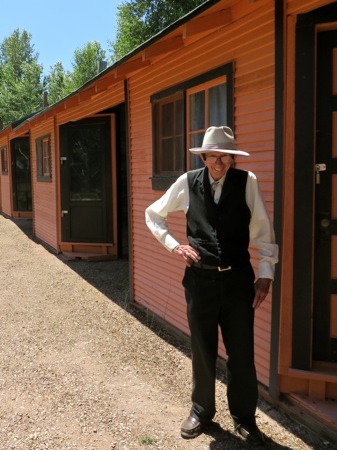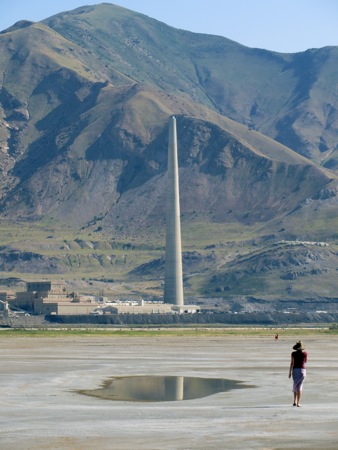By noon time, we had almost reached Fort Bridger, Wyoming, and we decided to go there for lunch. We took Business 80 through Lyman (population 2,115, elevation 6,706) and Urie (population 262, elevation 6,785), and thence into Fort Bridger (population 345, elevation 6,673) — three small towns spread along the broad green valley through which winds a narrow river. Jim Bridger, who established Fort Bridger, described the location in a letter from december, 1843: “The fort is in a beautiful location on Black’s Fork of Green River, receiving fine, fresh water from the snow on the Uinta Range. The streams are alive with mountain trout. It passes the fort in several channels, each lined with trees, kept alive by the moisture of the soil.” (quoted in R. S. Ellison, Fort Bridger: A Brief History [Wyoming State Archives, Museums, and Historical Department, 1931, 1981], p. 9)
We pulled in to the Fort Bridger State Historic Site and Museum, and asked the woman who collected our day use fee if there were a restaurant in town. She pointed across the street. We parked the car and walked across to Will-yum’s restaurant for a leisurely lunch — leisurely because neither we nor our waitress nor the owner and chief chef of Will-yum’s were in any great hurry.
The Fort Bridger State Historic Site proved to be very satisfying. It has remained untouched by modern curatorial trends, so there were no interactive displays, no over-researched,painfully-objective descriptive captions. Whoever set up the displays got us to use our imagination so that several different eras were brought to life: the original fort and trading post for the emigrant trains in the 1840s, the brief life of the Pony Express in 1860-1861, the U.S. military post in the 1880s, the tourist trade along the Lincoln Highway in the 1930s. I think my favorite part was the Black and Orange Cabins, a motel built in 1929, which is mostly restored. Kelvin Hoover, a costumed guide, showed us around. You can look in the windows of the cabins and see what it might have been like had you stayed in one in the 1930s: the tiny little wood stove with a kettle on it, the simple wood shelves, an old-fashioned Edison light bulb hanging from the ceiling. Each cabin had its own open garage, and there was a small power plant to generate electricity for the lights, but you had to walk down to the end of the cabins to use the outhouse.

Kelvin Hoover in front of Cabin no. 1 (photo credit: Carol Steinfeld)
As we drove west through Wyoming, we saw fewer cattle. We saw a few oil derricks, and mysterious industrial plants out in the middle of nowhere, and what appeared to be mines, and lots of wind turbines. I picked up a copy of the Wednesday, July 17, number of the weekly newspaper Green River Star, and found three articles by editor David Martin on wind farms; obviously wind farms are of growing importance in southwestern Wyoming. Martin reports that “Carbon County has nine wind farms comprising a total of 492 turbines,” and county commissioners in Sweetwater, Carbon, and Uinta counties continue to wrestle with how to regulate development of wind farms. The western landscape is not an empty wilderness, it is being heavily used by us humans for the extraction and exploitation of raw materials and energy.
In the late afternoon, we had gotten past Salt Lake City, and on a whim we pulled off the highway to see the Great Salt Lake. We pulled into the parking lot of Great Salt Lake Park and Saltair Beach. The water was a good distance from the parking lot, and we could see people walking out across the sand and mud towards the water. We started walking. The footing was mostly solid sand, but in places we had to walk through slippery sloppy mud a few inches deep; Carol was wearing flip-flops and she wailed that the mud was hot. The sun was hot, too, and the hot wind carried a distinctive odor, sort of like low tide. There were what appeared to be ice crystals in the mud at one point; but the crystals were salt, not ice.
When we were out near the water, I looked back at the Kennecott copper smelting plant and its huge smoke stack, over 1,000 feet tall. In the west, the stark beauty of the landscape is usually paired with some kind of crazy-ass human-built structure, often huge or sprawling, that’s so ugly it becomes stunningly beautiful:

